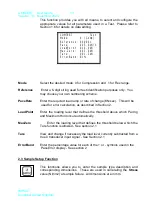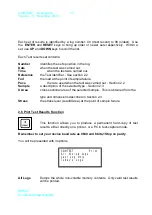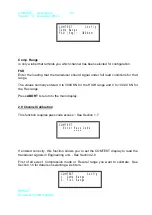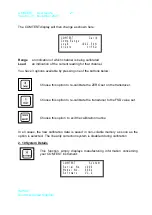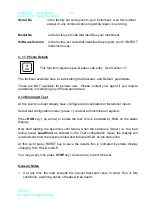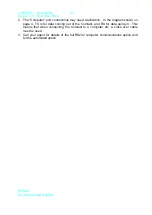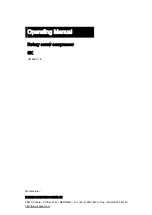
COMTEST User Guide
12
Version. 3.1 November 2003
IMPACT
Scotland, United Kingdom
Every ||| (three) symbols represent a percentage error equivalent to a parameter
ErrorBand
also configured as described in Section 2.2
Whilst a test is running, COMTEST will always store and display the largest load it has
measured so far. This feature, known here as
Maximum Hold
, allows you to monitor a
test result long after it has finished, i.e. sample failure occurred. To release the
display, and start a new test, you need to use the CLEAR/ABORT function key.
This function also creates a new log for the recent test results - See Section 2.4.
Logged results are held in non-volatile memory. This means that they are not lost even
when power to COMTEST is switched OFF. See Sections 2.5 and 2.6 for details on
access to these logged results.
Most of the time, the information given above will be all you need to use COMTEST.
However, to make more use of the instrument, you need to set-up not only Test but
also Sample characteristics, date and time, configure and calibrate the ranges, etc.
The rest of this manual shows you how to do this.
To access a function from the Main Display, press the key indicated in ea ch case. To
choose a function, follow the instructions given in Section 1.5 To cancel any unwanted
selection, use the
CLEAR /ABORT
key.
2.1 Tare Function
Use this function to remove any unwanted loading. This may occur
after platen or other equipment is installed on your test arrangement.
The function is available as long as the current load is below the
MaxZero
level. To
configure this, use the
TEST
function as described in Section 2.2
The displayed load value will be made 0. You can choose thi s function as many times
as needed. The amount currently tared from a true 0 load level can be viewed or
changed as described in Section 2.2
The Tare function is NOT a substitute for proper channel configuration and calibration.
When these are used as described in Sections 2.8 and 2.9, you set up the transducers
to produce correct and true Full-Scale and Zero signal levels
.
2.2 Test Set-up Function
















